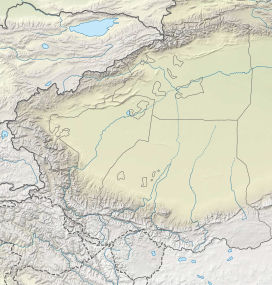| Mazar Pass (Sailiyake Pass) | |
|---|---|
| Chiragsaldi Pass | |
(top) southbound view (bottom) northbound view | |
| Elevation | 4,969 m (16,302 ft) [1] |
| Length | 40 kilometres (25 mi) [1] |
| Traversed by | |
| Location | Kargilik County, Xinjiang, China |
| Range | Kunlun Mountains |
| Coordinates | 36°34′44″N 77°00′13″E / 36.579°N 77.0035°E |
|
| |
| Mazar Pass | |||||||
|---|---|---|---|---|---|---|---|
| Traditional Chinese | 麻扎達坂 | ||||||
| Simplified Chinese | 麻扎达坂 | ||||||
| |||||||
| Alternative Chinese name | |||||||
| Traditional Chinese | 賽力亞克達坂 | ||||||
| Simplified Chinese | 赛力亚克达坂 | ||||||
| |||||||
Mazar Pass ( Chinese: 麻扎达坂; pinyin: Mázhā dábǎn), also refer to it as Sailyak Pass [2]( Chinese: 赛力亚克达坂; pinyin: Sàilìyàkè Dábǎn) [3] is a long mountain pass with numerous hairpin turns along China National Highway 219 (G219), the highway connecting Xinjiang and Tibet. The mountain pass crosses the Kunlun Mountains. It is between the villages of Kudi and Mazar in Kargilik County in southwestern Xinjiang. Western sources often refer to it as Chiragsaldi Pass. [4] [5]
The pass is located 240 kilometres (150 mi) from the northern terminus of the G219 highway. [6] At about 40 kilometres (25 mi) long, it is the longest mountain pass on the Xinjiang-Tibet highway. [6] [1] The highway was first completed in 1957, and fully asphalted in 2013. [5]
The small village to the south Mazar was so named because it was the site of two Uyghur mazars. The village contains a Chinese army service station. [6] In recent decades, it also serves as a truck stop for the G219 highway and stop for expeditions en route to K2. [4] [7]
Chiragsaldi Pass was the name used by British explorers during the late 1800s, likewise, Mazar village which at the time was only a caravan campsite was referred to as Chiragsaldi. [8] This name means "the lamp brew out" referencing the windiness of the campsite. [9] French army map from early 1900s showed Chiragsaldi Pass (Tchirak-Soldi) and Sailyak Pass (Sarrakh) were different mountain passes, one going west and other going east from the same valley. [10]
References
- ^
a
b
c 锈剑 (28 August 2018).
"穿越世界之巅的天路G219新藏线 一路探秘无人区的苍凉与雄壮". QQ News (in Chinese). Retrieved 23 January 2020.
海拔4969米的麻扎达坂,是新藏线上最长的达坂,上下各近40公里。
-
^ Institute of Glaciology and Geocryology (1992).
Proceedings of the Symposium on Mountain Glaciology relating to Human Activity held at Lanzhou, Gansu Province, China, 26-30 August 1991. International Glaciological Society. p. 136.
ISBN
978-0-946417-08-7.
Sailyak Pass
-
^ Xiao, Wenjiao; Hou, Quanlin; Li, Jiliang; Brian F., Windley; Hao, Jie; Fang, Aiming; Zhou, Hui; Wang, Zhihong; Chen, Hanlin; Zhang, Guocheng; Yuan, Chao (2000). "Tectonic facies and the archipelago-accretion process of the West Kunlun, China". Science in China Series D: Earth Sciences. 43 (S1): 134–143.
doi:
10.1007/BF02911939.
ISSN
1006-9313.
The mélange zone along the Sailiyake Daban and Kangxiwar is mainly composed of Triassic sand-stones and shales
- ^
a
b Brown, Chip (April 2012).
"K2".
National Geographic. Archived from
the original on 28 July 2018. Retrieved 23 January 2020.
After a night in the dimly lit Yecheng Electricity Hotel we drove over the Chiragsaldi Pass and crept through billows of dust at ten miles an hour until we reached a desolate truck stop called Mazar.
- ^
a
b
"Chiragsaldi Pass". dangerousroads.org. Retrieved 23 January 2020.
The road to the summit is called 219 National Road, also known as Tibet - Xinjiang Highway. Construction of this road started in 1951. It was completed in 1957 and fully paved with asphalt in 2013.
- ^
a
b
c 创意影像 (1 March 2017).
中国最美的20条摄影之路. Beijing Book Co. Inc. p. 173.
ISBN
978-7-5514-1685-6.
麻扎达坂麻扎达坂位于新藏公路北起240千米处,也叫赛力克达坂,...也是新藏线最长的达坂...麻扎达坂位于麻扎兵站的北方。...这里是新藏公路和进乔戈里峰的边防公里分岔口,应此地原有两座维吾尔人坟墓而得名。
-
^ Lysenko, Vladimir (June 1996).
"First Descent of the Chogir River in Xinjiang". Shangri La River Expeditions. Retrieved 23 January 2020.
Have covered through settlement Kokyar, Akaz Pass (of height of 3,000 m), settlement Kudi and, at last, very high Seraz Pass (4,947 m) and at two o'clock in the afternoon have reached Mazar (Mazar Dara). ... The Seraz Pass, of height of almost 5,000 meters, is rather good "looked" - it is the matter of hands of soldiers of Chinese building battalions.
-
^ Francis Younghusband (1888).
"A journey across Central Asia, from Manchuria and Peking to Kashmir, over the Mustagh Pass". Proceedings of the Royal Geographical Society and Monthly Record of Geography. Edward Stanford. pp. 504–505.
At the head of the Tisnaf river we left the track which leads over the Yangi Dawan to the Karakoram Pass and Leh, and struck off westward to the Chiragh Saldi Pass. ... The next day we struck the Yarkand river at the camping ground of Chiragh Saldi, which is the furthest point reached by Mr. Hayward in exploring the course of that river from its source downwards.
-
^ Henry Walter Bellew (1875).
Kashmir and Kashghar: A Narrative of the Journey of the Embassy to Kashghar in 1873-74. Trübner. p. 399.
Our next stage was Chiragh Saldi, "the lamp blew out" -- in reference to the winds of the locality -- fourteen miles.
-
^ Service géographique de l'armée (1906).
"Asie 1:1,000,000. flle 40N-78E, Kachgar" (Map). 1886 - Collections patrimoniales numérisées de Bordeaux Montaigne (in French). Retrieved 23 January 2020.
Tchirak-Soldi, Sarrakh, Yanghi-Davan


